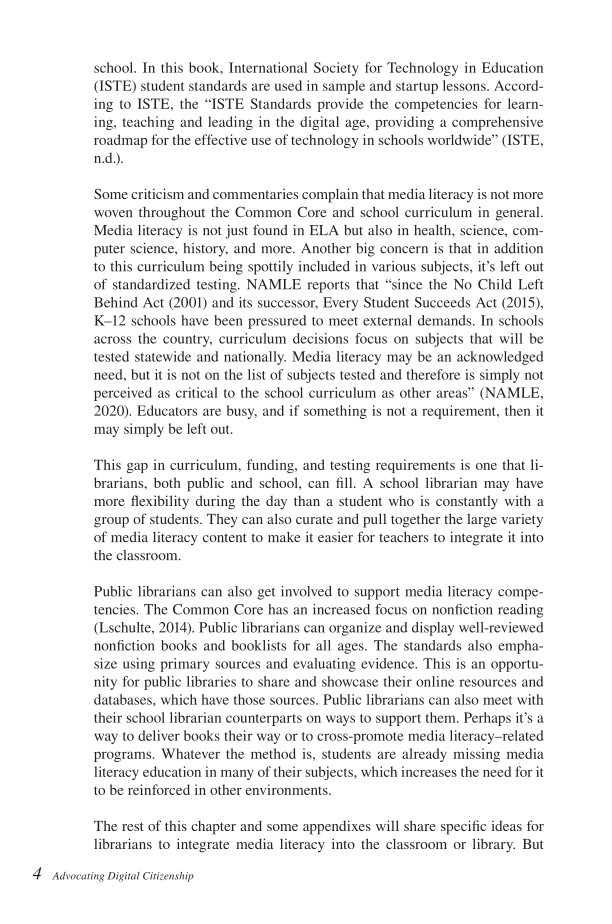4 Advocating Digital Citizenship school. In this book, International Society for Technology in Education (ISTE) student standards are used in sample and startup lessons. Accord- ing to ISTE, the “ISTE Standards provide the competencies for learn- ing, teaching and leading in the digital age, providing a comprehensive roadmap for the effective use of technology in schools worldwide” (ISTE, n.d.). Some criticism and commentaries complain that media literacy is not more woven throughout the Common Core and school curriculum in general. Media literacy is not just found in ELA but also in health, science, com- puter science, history, and more. Another big concern is that in addition to this curriculum being spottily included in various subjects, it’s left out of standardized testing. NAMLE reports that “since the No Child Left Behind Act (2001) and its successor, Every Student Succeeds Act (2015), K–12 schools have been pressured to meet external demands. In schools across the country, curriculum decisions focus on subjects that will be tested statewide and nationally. Media literacy may be an acknowledged need, but it is not on the list of subjects tested and therefore is simply not perceived as critical to the school curriculum as other areas” (NAMLE, 2020). Educators are busy, and if something is not a requirement, then it may simply be left out. This gap in curriculum, funding, and testing requirements is one that li- brarians, both public and school, can fill. A school librarian may have more flexibility during the day than a student who is constantly with a group of students. They can also curate and pull together the large variety of media literacy content to make it easier for teachers to integrate it into the classroom. Public librarians can also get involved to support media literacy compe- tencies. The Common Core has an increased focus on nonfiction reading (Lschulte, 2014). Public librarians can organize and display well-reviewed nonfiction books and booklists for all ages. The standards also empha- size using primary sources and evaluating evidence. This is an opportu- nity for public libraries to share and showcase their online resources and databases, which have those sources. Public librarians can also meet with their school librarian counterparts on ways to support them. Perhaps it’s a way to deliver books their way or to cross-promote media literacy–related programs. Whatever the method is, students are already missing media literacy education in many of their subjects, which increases the need for it to be reinforced in other environments. The rest of this chapter and some appendixes will share specific ideas for librarians to integrate media literacy into the classroom or library. But
Document Details My Account Print multiple pages
Print
You have printed 0 times in the last 24 hours.
Your print count will reset on at .
You may print 0 more time(s) before then.
You may print a maximum of 0 pages at a time.

































































































































































































